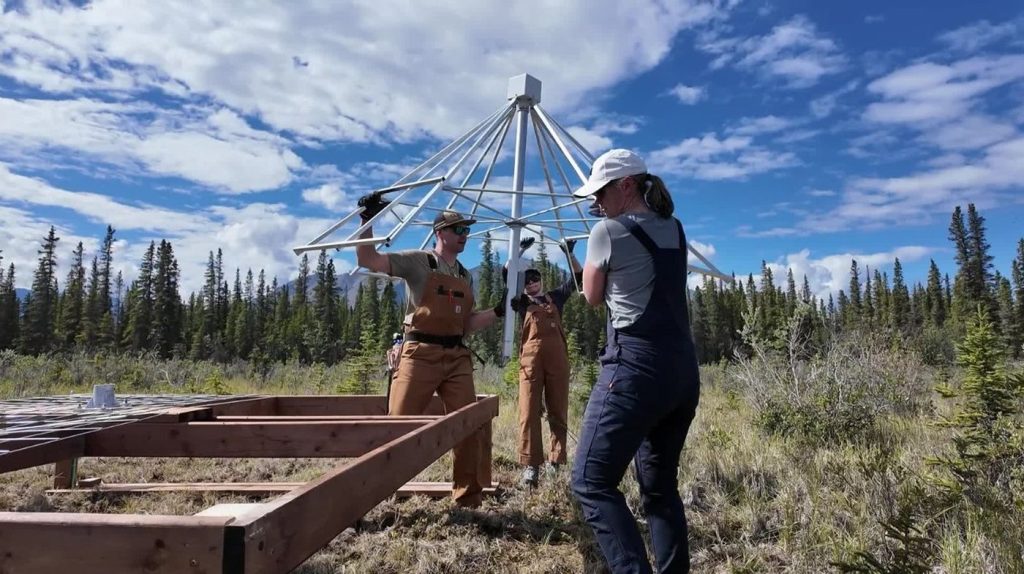Science
University of Calgary’s Sensors Gain Military Interest for Defense

Researchers at the University of Calgary have garnered significant attention from Canada’s military, the U.S. Navy, and NATO due to their innovative use of ground-based sensors for monitoring the near-Earth space environment. These sensors, part of the university’s space weather network, consist of 22 high-frequency remote devices, which resemble large metal umbrellas, strategically positioned across Canada and into the northern United States.
Susan Skone, a professor in the Department of Geomatics Engineering, emphasized the dual purpose of these sensors. While they play a vital role in studying space weather, they also support critical real-time systems essential for northern defense operations, natural resource exploration, and telecommunications. Skone highlighted their capability to differentiate between natural disruptions and those caused by human activities.
“This allows us to detect jamming, spoofing, and other forms of anomalous behavior in Canada’s space environment,” Skone explained. By integrating the data collected from these sensors into larger models, researchers can identify vulnerabilities and threats to navigation systems, such as GPS, which are susceptible to both natural and human-made interferences.
Collaboration with Defense Authorities
The relevance of this technology has grown as Canada modernizes its defensive systems, including the development of a radar system aimed at northern defense. Emma Spanswick, associate professor in the Department of Physics and Astronomy, noted the importance of this information in enhancing national security. The sensors have been in development for over four decades, and the research team has begun collaborating with Canada’s Department of National Defence and Defence Research and Development Canada.
“We started working with DND and DDRC to develop that capacity and some of these operational systems, which now use the model and the real-time data,” Spanswick stated. “Boom — now we’ve got a system that’s supporting two distinctive classes of users.” She described the project as “very cool,” underscoring the excitement surrounding its potential applications.
The interest from military agencies underscores the growing recognition of the strategic importance of space weather monitoring. With the capabilities to enhance national defense and support everyday navigation, the University of Calgary’s research is positioned at the intersection of science and security.
This report was first published on November 25, 2025, by The Canadian Press, with contributions from Bill Graveland.
-

 Politics3 weeks ago
Politics3 weeks agoSecwepemc First Nation Seeks Aboriginal Title Over Kamloops Area
-

 World4 months ago
World4 months agoScientists Unearth Ancient Antarctic Ice to Unlock Climate Secrets
-

 Entertainment5 months ago
Entertainment5 months agoTrump and McCormick to Announce $70 Billion Energy Investments
-

 Lifestyle4 months ago
Lifestyle4 months agoTransLink Launches Food Truck Program to Boost Revenue in Vancouver
-

 Science5 months ago
Science5 months agoFour Astronauts Return to Earth After International Space Station Mission
-

 Technology3 months ago
Technology3 months agoApple Notes Enhances Functionality with Markdown Support in macOS 26
-

 Top Stories2 months ago
Top Stories2 months agoUrgent Update: Fatal Crash on Highway 99 Claims Life of Pitt Meadows Man
-

 Lifestyle3 months ago
Lifestyle3 months agoManitoba’s Burger Champion Shines Again Amid Dining Innovations
-

 Politics4 months ago
Politics4 months agoUkrainian Tennis Star Elina Svitolina Faces Death Threats Online
-

 Sports5 months ago
Sports5 months agoSearch Underway for Missing Hunter Amid Hokkaido Bear Emergency
-

 Politics4 months ago
Politics4 months agoCarney Engages First Nations Leaders at Development Law Summit
-

 Technology5 months ago
Technology5 months agoFrosthaven Launches Early Access on July 31, 2025





















